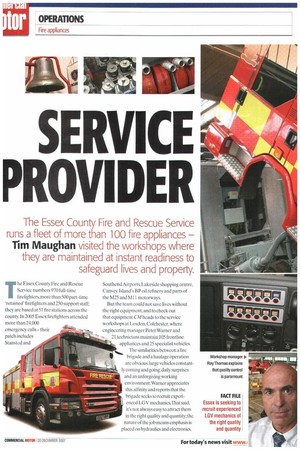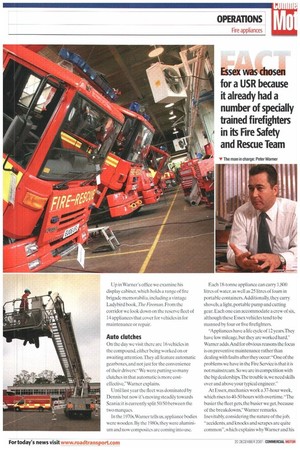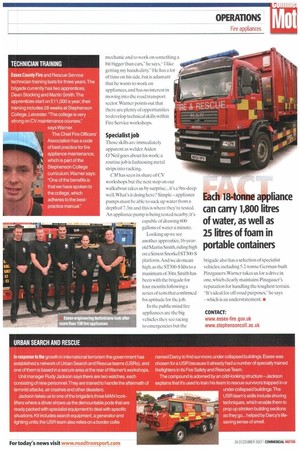SERVICE PROVIDER
Page 66

Page 67

Page 68

Page 69

If you've noticed an error in this article please click here to report it so we can fix it.
The Essex County Fire and Rescue Service runs a fleet of more than 100 fire appliances —
Tim Maughan visited the woRshops where they are maintained at instant readiness to safeguard lives and property.
The Essex County Fire and Rescue Service numbers 970 full-time firefighters, more than 500 part-time 'retained' firefighters and 250 support staff; they are based at 51 fire stations across the county. In 2005 Essex firefighters attended more than 24.000 emergency calls —their patch includes Stansted and Southend Airports, Lakeside shopping centre, Canvey Island's BP oil refinery and parts of the M25 and MI1 motonvays.
But the team could not save lives without the right equipment, and to check out that equipment CM heads to the service workshops at Lexden, Colchester, where engineering manager Peter Warner and 21 technicians maintain 105 frontline appliances and 25 specialist vehicles. The similarities between a lire brigade and a haulage operation are obvious:large vehicles constantly coming and going, daily surprises and an unforgiving working environment.Warner appreciates this affinity and reports that the brigade seeks to recruit experienced LGV mechanics.That said, it's not always easy to attract them in the right quality and quantity; the nature of the job means emphasis is placed on hydraulics and electronics. Up in Warner's office we examine his display cabinet, which holds a range of fire brigade memorabilia, including a vintage Ladybird book, The Fireman. From the corridor we look down on the reserve fleet of 14 appliances that cover for vehicles in for maintenance or repair.
Auto clutches On the day we visit there are 16 vehicles in the compound, either being worked on or awaiting attention.They all feature automatic gearboxes, and not just for the convenience of their drivers:" We were putting so many clutches in that automatic is more costeffective,"Warner explains.
Until last year the fleet was dominated by Dennis but now it's moving steadily towards Scania; it is currently split 50/50 between the two marques.
In the 1970s Warner tells us, appliance bodies were wooden.By the 1980s, they were aluminium and now composites are coming into use. Each 18-tonne appliance can carry 1,800 litres of water, as well as 25 litres of foam in portable containers.Additionally, they carry shovels, a light,portable pump and cutting gear. Each one can accommodate a crew of six, although these Essex vehicles tend to be manned by four or five firefighters.
"Appliances have a life cycle of 12 years.They have low mileage, but they are worked hard," Warner adds.And for obvious reasons the focus is on preventive maintenance rather than dealing with faults after they occur:"Orie of the problems we have in the Fire Service is that it is not mainstream. So we are in competition with the big dealerships,The trouble is, we need skills over and above your typical engineer."
At Essex, mechanics work a 37-hour week, which rises to 40-50 hours with overtime. The busier the fleet gets, the busier we get, because of the breakdowns," Warner remarks. Inevitably, considering the nature of the job, "accidents, and knocks and serapes are quite common", which explains why Warner and his colleagues have an affection for composite construction.
Quality control is paramount; workshop manager RayThomas reports that brake pads and shoes are replaced when they are still 10% above manufacturers' recommended wear limits.
Costly repairs
It seems that I irclighters are superstitious: when a particular station's appliance is repaired after a bump the rejuvenated vehicle is always allocated to a new station. And those repairs don't come cheap:Thomas recalls that when two Essex appliances collided it cost £160,000 to get them both back into service. "They are such highly specialised vehicles," Warner points out. Written-off vehicles are cannibalised for spares.
As well as servicing and repairs, the workshops routinely customise their appliances to make them that bit more efficient; we watch as an engineering technician installs some extra racking.
Next,Warner introduces us to apprentice Dean Stocking."I always wanted to be a mechanic and to work on something a bit bigger than cars," he says,hike getting my hands dirty." He has a lot of time on his side, but is adamant that he wants to work on appliances, and has no interest in moving into the road transport sector. Warner points out that there are plenty of opportunities to develop technical skills within Fire Service workshops
Specialist job
Those skills are immediately apparent as welder Aiden O'Neil goes about his work; a routine job is fashioning metal strips into racking.
CAI has seen its share of CV workshops but the next stop on our walkabout takes us by surprise.., it's a 9m-deep well. What's it doing here? Simple appliance pumps must be able to suck up water from a depth of 7.3m and this is where they're tested. An appliance pump is being tested nearby;it's capable of drawing 600 gallons of water a minute.
Looking up we see another apprentice,16-yearold Martin Smith, riding high on a Simon Snorkel ST300-S pl atform. And we do mean high, as the ST300-S lifts to a maximum of 30m. Smith has been with the brigade for four months following a series of tests that confirmed his aptitude for the job.
In the public mind fire appliances are the big vehicles they see racing to emergencies but the brigade also has a selection of specialist vehicles. including 5.2-tonne German-built Pinzgauers. Warner takes us for a drive in one, which clearly maintains Pinzgauer's reputation for handling the toughest terrain. "It's ideal for off-road purposes," he says -which is an understatement. •
































































































































































































